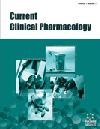- Home
- A-Z Publications
- Current Clinical Pharmacology
- Previous Issues
- Volume 5, Issue 2, 2010
Current Clinical Pharmacology - Volume 5, Issue 2, 2010
Volume 5, Issue 2, 2010
-
-
Hepatitis C Virus Infection and Antiviral Treatment in Marginal Zone Lymphomas
More LessAuthors: Luca Arcaini and Raffaele BrunoThe association between hepatitis C virus (HCV) infection and B-cell non-Hodgkin's lymphomas has been demonstrated in epidemiological studies, in particular in highly endemic geographical areas such as Italy, Japan and southern parts of United States. Marginal zone lymphomas are the histotypes that are most frequently associated with HCV infection. The WHO classification comprises extranodal marginal zone B-cell ly Read More
-
-
-
Intraperitoneal Drug Therapy: An Advantage
More LessAuthors: Kunal Chaudhary, Shadi Haddadin, Ravi Nistala and Chris PapageorgioThe peritoneum is a cavity which has been successfully utilized by nephrologists to perform peritoneal dialysis (PD) in patients with renal failure. The physiologic characteristic of the peritoneal cavity not only helps remove toxic metabolites from the body, but also provides a useful portal of entry in the body for several pharmacological agents. Several medications such as antibiotics are given via the intraperitoneal (IP) route Read More
-
-
-
The Treatment of Cardiovascular Disease Continuum: Focus on Pharmacologic Management and RAS Blockade
More LessAuthors: Steven G. Chrysant, George S. Chrysant, Catherine Chrysant and Mohammad ShirazThe cardiovascular disease continuum is a sequence of events, which begins with a host of risk factors consisting of diabetes mellitus, dyslipidemia, hypertension, smoking and visceral obesity. If left untreated, it will inexorably progress to atherosclerosis, CAD, myocardial infarction, left ventricular remodeling, LVH, left ventricular enlargement, and eventually end-stage heart failure and death. Treatment intervention at a Read More
-
-
-
Clinical Pharmacology and Lesion Penetrating Properties of Second- and Third-Line Antituberculous Agents Used in the Management of Multidrug-Resistant (MDR) and Extensively-Drug Resistant (XDR) Tuberculosis
More LessAuthors: Veronique Dartois and Clifton E. BarryFailure of first-line chemotherapy to cure tuberculosis (TB) patients occurs, in part, because of the development of resistance to isoniazid (INH) and rifampicin (RIF) the two most sterilizing agents in the four-drug regimen used to treat primary infections. Strains resistant to both INH and RIF are termed multidrug-resistant (MDR). Treatment options for MDR patients involve a complex array of twenty different drugs only two classe Read More
-
-
-
A Review of Clinical Pharmacokinetics and Pharmacodynamics of Galantamine, a Reversible Acetylcholinesterase Inhibitor for the Treatment of Alzheimer 's Disease, in Healthy Subjects and Patients
More LessAuthors: Fenglei Huang and Yali FuGalantamine is a reversible acetylcholinesterase inhibitor for the treatment of Alzheimer 's disease. Following oral administration, galantamine is rapidly absorbed and reaches Cmax in approximately one hour for immediate release (IR) tablets and four hours for extended-release (ER) capsules. Food has no clinically important effects on the absorption of galantamine. Galantamine displays dose-proportional pharmacoki Read More
-
-
-
Pretreatment by Hyperoxia - A Tool to Reduce Ischaemia-Reperfusion Injury in the Myocardium
More LessAuthors: Inga Karu, Peeter Tahepold, Arno Ruusalepp and Joel StarkopfAtherosclerosis leads to narrowing and occlusion of coronary arteries, resulting in inadequate oxygen supply for maintenance of normal oxidative metabolism. To avoid profound ischaemia and subsequent necrosis of cardiomyocytes, blood flow has to be restored by means of thrombolysis, percutaneous coronary intervention, or surgical revascularisation. Besides restoring oxygen supply to the cells, introduction of molecula Read More
-
-
-
Pharmacotherapy of Mixed Dyslipidemia in the Metabolic Syndrome
More LessBy Kei NakajimaPeople with metabolic syndrome (MetS) are at increased risk of type 2 diabetes and cardiovascular diseases, and often have increased triglyceride, reduced high-density lipoprotein cholesterol (HDL-C) and sometimes moderately increased low-density lipoprotein cholesterol (LDL-C) levels. Lifestyle intervention is critical for treating MetS, while pharmacotherapy of dyslipidemia in MetS remains controversial. Considering the Read More
-
Volumes & issues
Most Read This Month
Article
content/journals/ccp
Journal
10
5
false
en


